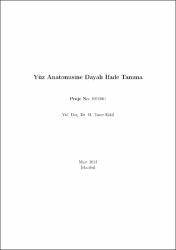| dc.contributor.author | Eskil, Mustafa Taner | en_US |
| dc.contributor.author | Başoğlu, Saba | en_US |
| dc.date.accessioned | 2020-05-12T09:22:24Z | |
| dc.date.available | 2020-05-12T09:22:24Z | |
| dc.date.issued | 2013-03 | |
| dc.identifier.citation | Eskil, M. T. & Başoğlu, S. (2013). Yüz anotomisine dayalı ifade tanıma. Tübitak, 1-71. | en_US |
| dc.identifier.uri | https://hdl.handle.net/11729/2313 | |
| dc.identifier.uri | https://app.trdizin.gov.tr/proje/TVRJNU1qWTI | |
| dc.description.abstract | Literatürde sunulan geometriye dayalı yüz ifadesi tanıma algoritmaları çoğunlukla araştırmacılar tarafından seçilen nirengi noktalarının devinimlerine veya yüz ifadesi kodlama sistemi (FACS) tarafından tanımlanan eylem birimlerinin etkinlik derecelerine odaklanır. Her iki yaklaşımda da nirengi noktaları, ifadenin en yoğun gözlemlendiği dudak, burun kenarları ve alın üzerinde konumlandırılır. Farklı kas etkinlikleri, birden fazla kasın etki alanında bulunan bu nirengi noktaları üzerinde benzer devinimlere neden olurlar. Bu nedenle, karmaşık ifadelerin belli noktalara konulan, sınırlı sayıdaki nirengi ile analizi oldukça zordur. Bu projede, yüz üzerinde kas etkinlik alanlarına dağıtılmış çok sayıda nirengi nokta-sının yüz ifadesinin oluşturulması sürecinde izlenmesi ile kas etkinlik derecelerinin belirlenmesini önerdik. Önerdiğimiz yüz ifadesi tanıma algoritması altı aşama içerir; (1) yüz modelinin deneğin yüzüne uyarlanması, (2) herhangi bir kasın etki alanında bulunan tüm nirengi noktalarının imge dizisinin ardışık çerçevelerinde izlenmesi, (3) baş yöneliminin belirlenmesi ve yüz modelinin imge üzerinde gözlemlenen yüz ile hizalanması, (4) yüze ait nirengi noktalarının deviniminden yola çıkarak model düğümlerinin yeni koordinatlarının kestirimi, (5) düğüm devinimlerinin kas kuvvetleri için çözülmesi, ve (6) elde edilen kas kuvvetleri ile yüz ifadesi sınıflandırılmasının yapılması. Algoritmamız, modelin yüze uyarlanması aşamasında yüz imgesi üzerinde nirengi noktalarının seçilmesi haricinde tamamen otomatiktir. Kas etkinliğine dayalı bu öznitelikleri temel ve belirsiz ifadelerin sınıflandırılması problemlerinde sınadık. Yedi adet temel yüz ifadesi üzerinde SVM sınıflandırıcısı ile %76 oranında başarı elde ettik. Bu oran, insanların ifade tanımadaki yetkinliklerine yakındır. Yedi temel ifadenin belirsiz gözlemlendiği çerçevelerde en yüksek başarıyı yine SVM sınıflandırıcısı ile %55 olarak elde ettik. Bu başarım, kas kuvvetlerinin genellikle hafif ve ani görülen istemsiz ifadelerin seziminde de başarılı olabileceğini göstermektedir. Kas kuvvetleri, yüz ifadesinin oluşturulmasındaki temel fiziksel gerçekliği yansıtan özniteliklerdir. Kas etkinliklerinin hassasiyetle kestirimi, belirsiz ifade değişikliklerinin sezimini sağladığı gibi, karmaşık yüz ifadelerinin sınıflandırılmalarını kolaylaştıracaktır. Ek olarak, araştırmacılar veya uzmanlar tarafından seçilen nirengi devinimleri ile kısıtlı kal-mayan bu yaklaşım, duygular ve yüz ifadeleri arasında bilinmeyen bağıntıların ortaya çıkarılmasını sağlayabilecektir. | en_US |
| dc.description.abstract | The geometric approaches to facial expression recognition commonly focus on the displa-cement of feature points that are selected by the researchers or the action units that aredefined by the facial action coding system (FACS). In both approaches the feature pointsare carefully located on lips, nose and the forehead, where an expression is observed at itsfull strength. Since these regions are under the influence of multiple muscles, distinct mus-cular activities could result in similar displacements of the feature points. Hence, analysisof complex expressions through a set of specific feature points is quite difficult.In this project we propose to extract the facial muscle activity levels through multiplepoints distributed over the muscular regions of influence. The proposed algorithm consistsof; (1) semi–automatic customization of the face model to a subject, (2) identification andtracking of facial features that reside in the region of influence of a muscle, (3) estimationof head orientation and alignment of the face model with the observed face, (4) estima-tion of relative displacements of vertices that produce facial expressions, (5) solving vertexdisplacements to obtain muscle forces, and (6) classification of facial expression with themuscle force features. Our algorithm requires manual intervention only in the stage ofmodel customization.We demonstrate the representative power of the proposed muscle–based features onclassification problems of seven basic and subtle expressions. The best performance onthe classification problem of basic expressions was 76%, obtained by use of SVM. Thisresult is close to the performance of humans in facial expression recognition. Our bestperformance for classification of seven subtle expressions was %55, once again by use ofSVM. This figure implies that muscle–based features are good candidates for involuntaryexpressions, which are often subtle and instantaneous.Muscle forces can be considered as the ultimate base functions that anatomicallycompose all expressions. Increased reliability in extraction of muscle forces will enabledetection and classification of subtle and complex expressions with higher precision. Mo-reover, the proposed algorithm may be used to reveal unknown mechanisms of emotionsand expressions as it is not limited to a predefined set of heuristic features. | en_US |
| dc.description.sponsorship | TÜBİTAK | en_US |
| dc.language.iso | tur | en_US |
| dc.publisher | Tübitak | en_US |
| dc.rights | info:eu-repo/semantics/openAccess | en_US |
| dc.rights | Attribution-NonCommercial-NoDerivs 3.0 United States | * |
| dc.rights.uri | http://creativecommons.org/licenses/by-nc-nd/3.0/us/ | * |
| dc.subject | Yüz anatomisi | en_US |
| dc.subject | Kas kuvvetleri | en_US |
| dc.subject | Öznitelik | en_US |
| dc.subject | FACS | en_US |
| dc.subject | Belirsiz ifadeler | en_US |
| dc.subject | Facial anatomy | en_US |
| dc.subject | Muscle forces | en_US |
| dc.subject | Features | en_US |
| dc.subject | Subtle expressions | en_US |
| dc.title | Yüz anotomisine dayalı ifade tanıma | en_US |
| dc.type | project | en_US |
| dc.contributor.department | Işık Üniversitesi, Mühendislik Fakültesi, Bilgisayar Mühendisliği Bölümü | en_US |
| dc.contributor.department | Işık University, Faculty of Engineering, Department of Computer Engineering | en_US |
| dc.contributor.authorID | 0000-0003-0298-0690 | |
| dc.relation.tubitak | info:eu-repo/grantAgreement/TUBITAK/EEEAG/109E061 | |
| dc.relation.publicationcategory | Diğer | en_US |
| dc.contributor.institutionauthor | Eskil, Mustafa Taner | en_US |
| dc.contributor.institutionauthor | Başoğlu, Saba | en_US |




















